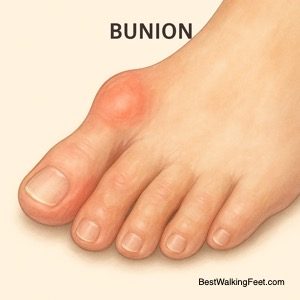Foot pain can severely limit your mobility—but knowing the source of the discomfort is key to choosing the right treatment. Bunion, gout, and hammertoe are three of the most common culprits. While they can all affect the toes and cause pain or swelling, each condition has a unique cause and treatment path. This article helps you distinguish between them and offers practical guidance for managing or preventing each.Comparison Table: Best Shoes for Hammertoes
What Is a Bunion?

A bunion is a structural deformity that develops at the base of the big toe, causing the joint to bulge outward. Over time, the big toe may start leaning inward toward the second toe. Bunions form gradually, often triggered by years of pressure from tight or ill-fitting shoes, inherited foot structure, or underlying conditions such as arthritis.
Common symptoms include a visible bump, dull aching pain, swelling, and limited movement. The pain tends to worsen with prolonged standing or wearing narrow shoes. While early intervention with wide-toe box shoes and bunion pads can help, more severe bunions may require surgery.
If you’re struggling with bunion pain, supportive footwear can make a big difference. Check out these guides from BestWalkingFeet.com on the best shoes for bunions.
What Is Gout?

Gout is an inflammatory form of arthritis caused by a buildup of uric acid crystals in the joints. It most often strikes the joint at the base of the big toe. Unlike bunions and hammertoe, gout comes on quickly, often overnight, with intense pain, redness, heat, and swelling.
Gout is linked to high uric acid levels in the blood, which can be triggered by dehydration, a diet high in purines (like red meat and shellfish), alcohol, and certain medications. Treatment typically includes anti-inflammatory drugs like NSAIDs or colchicine for flare-ups, and long-term medications such as allopurinol to control uric acid levels. Diet and lifestyle changes play a major role in preventing future attacks.
According to the CDC, gout affects about 9.2 million adults in the U.S., or roughly 3.9% of the population.
See also: Best shoes for gout
What Is Hammertoe?

Hammertoe is a deformity in which one of the smaller toes—usually the second, third, or fourth—bends downward at the middle joint. This condition can be flexible in early stages or rigid in more advanced cases. It often results from muscle imbalance, trauma, or prolonged use of high heels and tight shoes.
Symptoms include a curled toe, pain when wearing shoes, calluses on the top of the joint, and difficulty straightening the toe. While mild cases can often be treated with foot exercises and proper footwear, rigid deformities may need surgical correction.
To find shoes that reduce pressure on curled or deformed toes, browse BestWalkingFeet.com’s recommendations for hammertoes.
How to Tell the Difference
Although bunions, gout, and hammertoe can all cause foot pain, the key differences lie in onset, appearance, and cause.
- Bunions appear as a slow-developing bony bump at the big toe joint and often cause a persistent ache.
- Gout arrives suddenly, with extreme, sharp pain and noticeable redness and swelling. The joint often feels hot to the touch.
- Hammertoes involve a visible downward bend in one or more toes, typically developing gradually and causing pain when shoes rub the joint.
Diagnosis often involves a physical exam. X-rays can confirm bunion or hammertoe structure, while a blood test or joint fluid analysis may be used to confirm gout.
Related Foot Health Stats
Here’s how common these foot conditions are:
- Bunions affect about 23% of adults aged 18 to 65, and over 35% of those 65 and older (National Center for Biotechnology Information).
- Gout is the most common inflammatory arthritis in the U.S., with 9.2 million adults diagnosed (CDC).
- Hammertoe affects more than 7 million Americans, most commonly older women who wear restrictive footwear.
Treatment Options
Each condition has its own treatment path, depending on severity and patient lifestyle.
- For bunions, early treatment involves wearing properly fitting shoes, orthotics, and using ice or over-the-counter pain relievers. Severe cases may require a bunionectomy.
- For gout, acute attacks are treated with NSAIDs or corticosteroids. Long-term management includes medications like allopurinol and dietary modifications.
- For hammertoe, switching to low-heeled, roomy shoes and using toe exercises or splints can help in early stages. Surgery is considered when deformity becomes rigid or painful.
Footwear is the best option to manage these conditions. See shoes for Bunions, Gout and Hammertoes